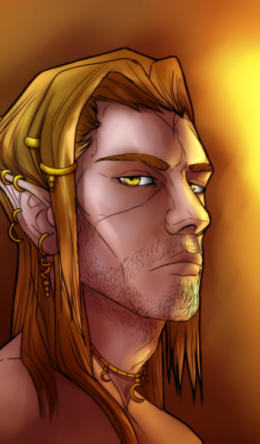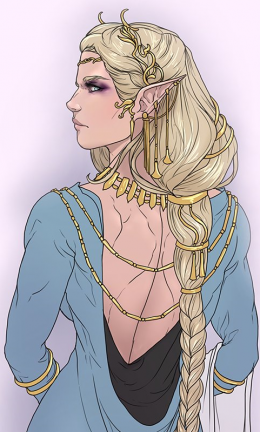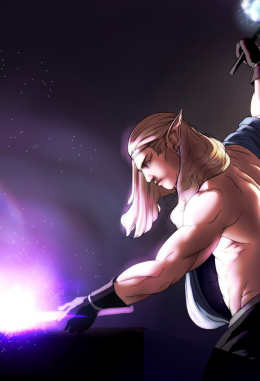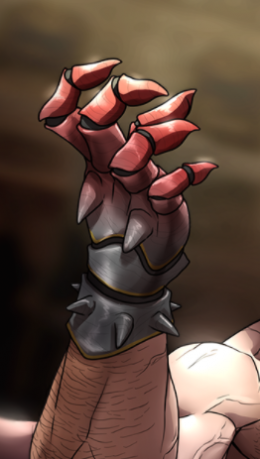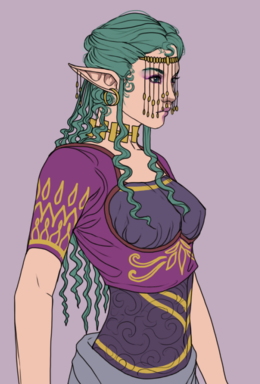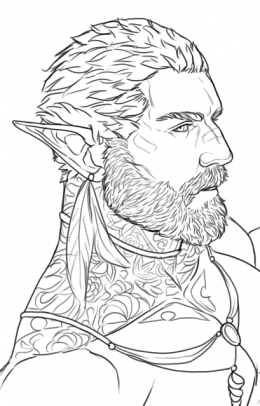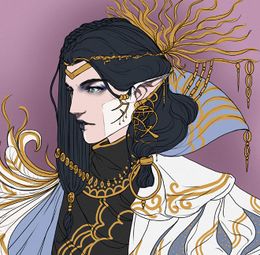Teledden
| Teledden | |
|---|---|
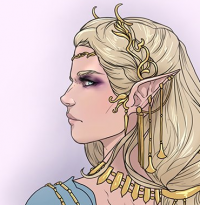 | |
| Race | |
| Pronunciation | Teled-enn |
| Classification | Magus |
| Common Nicknames |
|
| Languages | Altalar. |
| Racial Traits | |
| Distinctions | Careful, charismatic and wise high Elves. |
| Maximum Age | 500 |
| Height | Tall |
The Teledden are the classical high Elves: skilled in magic and clever with their words, graceful and ancient. As the oldest Elven culture, they consider themselves the natural leaders of their people, and steep themselves in the history and politics necessary to do so. While many other Elven have specialized away from their Teledden roots, swearing oaths to gods or being changed by powers from beyond the Veil, the Teledden are true to their original nature, the same in body and mind as those who walked the earth ten thousand years ago.
Core Identity
Crown of the World
Few peoples have a history as long as that of the Teledden. For millennia after they unified into the first Elven Empire, the Allorn Empire, they achieved a string of victories over their many opponents that defined their culture and that of all the Elves to come. Although their domain is not what it used to be, the Teledden truly believe that they are capable of recapturing the glory they have lost, and that they can and should take a leading role in world affairs - even if not all Teledden believe in the Allorn Empire itself. The Crown of the World, the legendary regalia of the Allorn Empresses, is a physical object: but also a metaphor for the Allorn Empire’s legacy, the legacy of the world that the Teledden built, and everyone else is just living in.
Magisterial
The Teledden are some of Aloria’s most capable Mages. This is not due to any inherent racial strength, but due to millennia spent refining and utilizing the craft when it was at the height of its power. After all, Magic was far stronger before Cataclysm, as any Teledden of sufficient age to remember those days would wistfully recall. While they have a strong bias towards Exist Magic due to their religion, the Teledden are not especially dogmatic about it, and see any and all kinds of Magic, even Primal Magic that wants to see other Magic erased, as a tool. Therefore it is only in the Teledden heartlands that records on all manner of arcane lore are freely kept and studied, and no information in pursuit of enlarging the art is taboo.
Estellian
There is a focus in the Estellon religion on achieving perfection and being the best and most skillful person one can be. As those with the longest history of observing Estellon, the Teledden have this notion baked into their culture in a way few others do. It is encouraged that Teledden players read the Estellon page, as there are concepts there relevant to playing a Teledden that are not double-stated on this page. Most important to understand is that the Teledden concept of ruling the world, the history of the Allorn Empire, and the Estellon religion are all tied together: in fact, the eldest of the Estellon gods, Elleyon, is considered the patron deity of the Allorn Empire, while the hunter god Ghilland enabled Allorn slavery by preaching that their actions were a benevolent civilizing mission.
Origins
The Teledden first arose thirty thousand years ago, though their history does not truly begin until their first Empress, Talea, created their Allorn Empire in 10000 BC. Records from this period are unclear, but it is known that Talea unified the divided kingdoms of the Teledden both as general and prophet of the goddess Estel, a powerful magical deity with a pantheon of gods who are now synonymous with Teledden civilization. Destroying their rival civilization (the Asha Dewamenet Empire to the north) and reducing them to slavery, the Teledden would spend the next millennia leading their cousin-Races the Fin’ullen, Suvial, and Solvaan under the banner of the Allorn Empire. The reigns of legendary empresses are innumerable: the Teledden explored every continent there was to explore, met every people there was to meet, although the Fin’ullen did most of the sailing. But as the Empire grew old and swelled with new ideas, religions, and cultures, it destabilized. The ways of Talea’s days lost popularity as Cults arose under charismatic preachers and influential generals, each believing there was a different, better way for the Allorn Empire to move forward. And by 1000 BC, it was tearing itself apart. Magic was stronger in the days of the Teledden: their Mage-Wars saw casualties and destruction on a level unthinkable in the modern day, entire continents cracking and collapsing into the ocean.
By 100 BC, the Empress was little more than a figurehead, while powerful nobles ran the hopelessly decentralized country. The true death knell of the Empire was the Night of the Weeping Stars, where those who had turned from Estel worship to the Void slaughtered the clergy and eliminated the final opposition to their rule. Other separatist groups, such as the Dragon-worshiping Isldar, self-evolving Maquixtl, and Demon-hating Sihndar, had long left and been either pursued or battled by the Allorn Empire, even as it fell from the inside. The Cataclysm which followed, marking 0 AC, was something experienced by the world, but by the Teledden most of all. The power of Magic was ripped from the world, cities torn asunder, citizens warped and consumed by the landscape, and the gods nowhere to be seen. The sorrowful tales are many of the end of the final Empress in the charge against Demons and the collapse of Allorn civilization. But, not all was over yet: in the centuries since, through war with the ambitious Human-led Regalian Empire and the recent (309 AC) appearance of one who proclaims themselves Talea reborn (though some Teledden doubt their legitimacy), the Teledden fight on in the hopes that they might one day overcome their usurping rivals and retake the world.
The legacy of Teledden rule is incredibly complicated. Much of the western world was built by the Allorn Empire, including where Regalia is today. The arts, sciences, and technology progressed far faster than they do in the modern day, propelled by powerful Magic, and the average Allorn citizen enjoyed a standard of living free of famine, plague, poverty, and conflict. However, the Allorn Empire was sustained by a vast underclass of slavery and forced labor of non-citizens, who were many. Any non-Elves the Allorn state conquered (especially the Asha, whose own history was erased) were stripped of their rights and put to work for generations spanning millennia, giving rise to the Asha, Daendroque, and other cultures as known in the modern day, as well as the Allorn-loving Ithanians’ slaving habits. While it is impossible to deny the skill the Teledden had and the glory they achieved, it is also impossible to divorce their great accomplishments from the evils they committed, and a single conversation with any non-Elves whose family roots lie in the Allorn Empire is enough to show how little love is held for the Allorn past there.
Design
Subraces
The Teledden have a secondary subrace called the Minoor, who are mechanically and visually identical but represent a small group of Teledden who diverged due to isolation. The Minoor are discussed in the Worldview section under a separate subheader.
Mental Characteristics
The Teledden are regal and poised, having a certain way of carrying themselves that makes them stand out in any crowd. Debate and mental sharpness are prized in Teledden culture, making words a favored way of solving problems. They are also stereotyped as arrogant: but it is more accurate to say that all Teledden have a presence, which some of them wield as arrogance. Teledden society raises each and every person to be a professional and a paragon of something, and to never let themselves be a wallflower or let someone else speak for them without express and total agreement. They know their own worth: always careful to extract something in an agreement, the Teledden are incredibly difficult to take advantage of, and always shrewd in a deal. However, most important of all to remember when playing a Teledden is that the Teledden culture is the most dignified one in Aloria. No amount of seething hatred can make a Teledden break their public face or lose their cool unless they are truly pushed to their breaking point. Curses, slang, and immature behavior do not exist in the Teledden homeland, meaning that any Teledden who adopts these quirks would have done so abroad.
Physical Characteristics
Teledden are, visually, the baseline Elves: they can have any skin color that a real-world human can, but must have light hair (blond, brown, red, white, light blue, light green) and light eyes (blue, green, gray, hazel). They have angular features, high cheekbones, and long pointed tears. Their culture encourages longer hairstyles, both as a sign of prestige and because they find all the styling options more attractive. The Teledden have less gender dimorphism than other Races: especially facially, their men and women can look quite similar. While Teledden are typically Mages, the common misconception that they cannot be muscular is wrong. Famous Teledden warriors and champions have existed, though historically they have mostly relied on the Fin’ullen and Solvaan for this, leading to a smaller presence overall. Teledden are ageless: they look young forever, even into old age, but can choose to look older inside of adult age ranges.
Teledden in Regalia
Teledden in Regalia can often be found in the cosmopolitan cities which are accepting of Magic, either as remnants of the Allorn-era population or more recent immigrants looking to make a new name for themselves away from the old country where expectations and consequences are very high. Many find work as teachers, both in mundane academic subjects and in the Arcane field, and their perfect literacy rate and centuries of experience make them prized sages and intellectuals. Others become political advisors, taught well by the cutthroat world of Daen courts.
Heritage Traits
When designing a Character, Proficiency Points allow for a limited Ability selection with Point Buy Packs. Heritage Traits adds free Packs and Mechanics on top of that to help with cultural themes. Free Packs grant Abilities usually, while Mechanics change the way a character functions in Roleplay through subtle, and usually out of Combat ways. In essence, Mechanics just add aesthetic flair that invest in the niche of each culture. Free Packs never raise Proficiency Points, but the character must be able to purchase them normally. (ex. if a character is a certain Affinity that locks them out of a category, they cannot take that specific free pack and must choose the alternative option.) If a Free Pack grants Magic of some type, that Magic can be of any Alignment the character can normally choose, or limited to a select alignment, which will always be written in the Free Pack description.
Mixed Heritage characters (i.e. characters born from two parents of different Cultures) may take one parent's 'Free Packs' and mix and match up to 5 Mechanics from both parents, although some Peoples cannot produce Mixed Heritage children (due to Magical/Fantasy reasons).
Free Packs
- Teledden choose two Packs from Magic Point Buy for free.
Mechanics
- Teledden can see things from incredibly far away if they focus, able to spot an eagle landing a kilometer away or a coin being flipped across a town. Ask DM for Event use.
- Teledden do not need to sleep, but can do so if they wish, or enter into a trancelike state of meditation that approximates sleep but leaves them watchful.
- Teledden, when using Persuasion Dice Rolls on Nobles or Non-Regalian Diplomats, gain +2 to their Persuasion Dice Roll, and the Persuasion Cap is also increased by +2.
- Teledden when choosing to use Radiant or Sinistral Magic, cannot be forced by an Ability/Mechanic to use the opposite. (ex. If they use Sinistral, it is always Sinistral, and vice versa)
- Teledden can gain additional Event Insight and Options with Allorn or Allorn-Adjacent NPCs, which may grant them opportunities other characters would not have (at discretion of Event DM).
Language
The Teledden language is shared with the Fin’ullen and Solvaan (not the Suvial, who do have their own language), just called Altalar. Altalar is a modernized version of the Allorn Language that the Teledden once spoke too, but that language is essentially dead in the modern era save for some dialects that still survive in enclaves. While Ailor call the Teledden language just Altalar, its actual name is Ïsursa’ïos, or translated to ‘The God-Written Tongue’. The Altalar language is a fantasy language that has no real-life equivalent, and is specifically also not Tolkien Elven. It is graceful and melodic, sing-song without hard or unpleasant sounds. Teledden follow Allorn naming principles, the most formal of all Elven Races. It starts with a first name, followed by a family name and then a place of origin. Middle names are optional.
A list of Teledden male coded names: Astadhel, Astannel, Alonnel, Erhennen, Ilhannon, Lanassil, Telassel, Tessalai, Usalan, Coravaan, Menyavaan, Meryavaan, Ustannir, Leirannir, most male names end in -el, -en, -on, -il, -el, -an, -ir.
A list of Teledden female coded names: Ulsanna, Meirenna, Lihanira, Ullaera, Sallora, Follanna, Astaira, Menvaela, Inneia, Sinneia, Valona, Heraine, Yllaine, most female names end in -na, -ra, -la, -ia, -ne, -eia.
Family names sound relatively similar, while a place of origin is often Bel-[Town], for example Bel-Mandaar, Bel-Heraan, Bel-Vastail, Bel-Ulhaen. Some aristocratic names can be more complicated than this. If you would like to make a larger Teledden name, feel free to use the RP Community Discord Ticket Bot to ask for advice.
Religion
The majority of Teledden are Estellon worshipers, with minorities abroad converting to other religions. As the Teledden do not have any particular nuance to their Estellon worship and champion its most standard form, it is encouraged to read the page for more details.
Families
Childhood
Teledden children are hands-off very quickly, to an extent that other cultures might consider it unusual. Teledden parents have absolutely no problem leaving their child to discover the world on their own and grow for themselves, as due to the immense lifespan Teledden have, a little wasted time is not such a big issue as might be compared to someone else. However, despite this, there is some pressure and expectation that they will succeed. Very common is for Teledden children in the large cities where old infrastructure still remains to be sent off to the ancient Mage-Academies (which no longer teach only Magic, but the material and natural sciences as well) to gain a proper education. Whatever the case, Teledden childhood is short compared to their lifespan, as they are treated like adults rather early in life and expected to maturely realize their own decisions and wants.
Adulthood
Teledden adulthood is often spent in pursuit of a profession, and perfecting that profession. Once a Teledden has selected their trade, it is very rare that they stray from it at all, leading to many artisans who have spent centuries at their work and scholars who have spent decades lost in libraries. Transitioning disciplines is considered an almost traumatic thing in Teledden culture, as it is viewed as now needing to “catch up” to everyone who was already there. That said, most Teledden do move around once or twice before deciding where they will want to settle down. By the time a Teledden is around age 100, they are considered not just an adult, but an adult who is performing the trade that they will perform for the rest of their lives, and worthy of respect beyond the surface politeness granted to a younger person.
Romance & Gender Norms
Teledden romance is stereotyped as very stiff and formal, with gift exchanges between families and weeks of painstaking buildup to the slightest show of affection. This is mostly from an Ailor point of view; the truth is moreso that the way that Elves as a whole and in this case specifically Teledden express love, hate, and friendship are very different from how an Ailor might. Teledden feel deeply for their friends, and take an interest in them that would imply romantic attachment in most Ailor cultures, whereas in truth the situation is likely completely platonic. The reason that Teledden take so long to build to a relationship, therefore, is that it is far more difficult to discern what is just an expression of closeness and care, and what has a romantic implication, tending to assume the former until it is very literally spelled out right in front of them. Teledden do not have gender norms, as the Teledden see no functional distinction between the roles of different people based on birth.
Fashion
Teledden fashion is what one thinks of when dreaming up the Allorn Empire. Flowing robes with gold trim, ornate and smooth clothes that make the wearer look graceful, carefully color-chosen and complimented. While Teledden enjoy opulence, they do not obligate themselves to look opulent all the time: but looking presentable is a must, and no Teledden would be caught dead in any public place looking out of order. The most stereotypically Teledden piece of dress is the Ylovlaë, or the shoulder-projects, large metal pauldrons that are a part of courtly wear. Large, elaborate, and difficult to maneuver, they are a Teledden’s sort of personal heraldry, often commissioned at important milestones in their lives and replete with Arcane sigils of power and personal significance. Coronets, headbands, and circlets are also very common, and in general Teledden love to maintain large and varied wardrobes and accessorize heavily with earrings, beads, and as much jewelry as makes sense without looking overly performative or tacky. Almost all Teledden wear their hair long, with the exception of soldiers who can get away with neck-length cuts, and anything else is seen as strange and barbaric.
World View
World View is deeper content that helps give Teledden flavor and depth.
Minoor
The Minoor are a distinct and separate culture of Teledden, Cretan-inspired and usually found with green or blue hair, that were created from an isolated colony that was lost in the chaos and destruction of Cataclysm. Originally refugees from the Mage-Wars, the Minoor were forced to turn to the magic labyrinth called the Minolassar under their capital city to survive, and forced as well to emancipate the slaves they had brought with them, as a revolt would have been the end of them. Over time, the more inclusive culture this created eventually separated the Minoor from their mainland cousins, leaving them mostly unrecognizable.
- Minoor society does not have any legislation or formal law code. There is a societal understanding that crime is bad, but crime is handled on a local level by either the palace scribes, or society itself. If someone feels slighted by someone else, the problem is proposed in a forum, usually at a town square. If the crowd jeers at the accuser, they don’t have a case and their matter is over.
- The Minoor do not have a formal government, but rather have something called a Palace Economy. What this means is that the land is covered in Palace structures, many of which have been around for hundreds of years, which manage the land in a rough radius around them.
- To the Minoor,
- Currency is illegal. Capitalism is illegal, all financial business with other nations is arranged by public consensus through the palace scribes.
- Foreign trade is illegal. All produce must come through the Palace economy, or it must be thrown into the ocean and perish.
- Slavery is illegal. But Minoor are not permitted to interfere with other slave-owning populations or try to free any Slaves.
- Royalty is illegal. But Minoor are not permitted to interfere with other royal systems, and if existing in one abroad must obey it.
- Nobility is illegal. But palace scribes have consensual nobility by virtue of their hard work and merit, and foreign nobility must be respected.
- Mages are not permitted to use their Magic in any part of their barter produce or work, unless that Magic in itself provides irreplaceable labor.
- Consumption of meat or other dairy products is illegal. Pescetarianism is mandatory on the Minoor Isles and consuming the meat of cattle is a high crime.
- Minoor architecture is often broad rather than tall, with deep vaults and expanses of maze-like corridors and columned garden-rooms to create a space that is difficult to navigate without getting lost.
- The unique trait of Minoor hair is a confusion to most, as some believe it only occurred after the Cataclysm, while others claim it to be much older, by centuries if not millennia. This is not helped by the myriad mutations, corruptions and fashion styles which cycled through the Allorn Empire in its final millennia of life, giving enormous visual difference on a purely aesthetic level.
- Staying true to Minoor Culture while outside of the Minoor Isle is very hard for Minoor Altalar. There is a general understanding among the Minoor that the world outside of their island is not as enlightened as them, and that this isn’t strictly their fault, because they did not go through the same tragedy and trauma as the early Minoor when it was life or death.
Magic
Teledden spent millennia perfecting and transmitting the use of Magic, and so have a formal culture centered around its wielding (and how to do so properly) that far outstrips that of any other nation. While Ailor might see Magic as a tool to get necessary work done, for a Teledden, it is a freedom as common and as necessary as literacy. Following is some pertinent information for Teledden Mages, but also for Teledden in general.
- Teledden do recognize actual “schools” inside of Magic usage, formally defined by them. While other peoples usually practice a mixture of different spell types and learn whatever suits their needs in the moment, Teledden are usually a distinct type of Mage. For example, Teledden artillery Mages are feared across Daen for their ability to wield the destructive power of fire from kilometers away, and Teledden light Mages are known as some of the most effective (though snide) healers available in Aloria. Specialization is key, and to the Teledden, a jack of all trades is a master of none. A Mage who cannot boast of their proud lineage of masters who have been practicing the same type of Magic as them for millennia is no Mage at all, just an upjumped cutthroat who thinks they know a few party tricks.
- The Teledden maintain a logographic script, not unlike the Sihai script, for the transmission of Magical information. While the letters used by the western world in the present day are their invention as well, the Teledden have always found that this logography is more effective for communicating in the idea-based realm of Magic, where it is useful to be able to acutely summarize principles. A spell component can be described as a character, while a more complex spell is a compound series of characters, usually taken to mean sentences like “long-distance fire-based destructive area spell.”
- Teledden Magic schools exist to serve all parts of society, and usually even the poor ones are well-funded by Princes (not just altruistically, as it is an excellent way to launder money). That said, the most famous ones are the elite academies that cater to the children of the Allorn-era aristocracy and the Archmage lineages that still dominate Arcane doctrine. These schools tutor in both general magic and more advanced specialization at the graduate level, producing excellent students who are in control of their own spellcraft and know how to keep away opportunistic Demons from latching onto their souls.
- Teledden Magic schools are notorious for their sororities. While it was far worse in the Allorn days, with actual halves of cities being destroyed in “pranks” and other competitions between groups that disliked each other, the tradition of young women with too much power running amok in the large cities is far from over. While in other parts of the world, irresponsible behavior is usually the responsibility of fraternities, it is the Teledden women who are far, far worse. Assuming wrongly about this has gotten gullible exchange students into much trouble over the centuries.
- Older Teledden usually prefer the feeling of casting through conduits such as staves, wands, or books. While these do not actually make the spells any stronger, having a conduit to cast through gives a Mage some extra bodily stability, and the physical memory of standing a certain way to cast a certain spell can help make sure that results are accurate every time for a student who is still learning. Maintaining perfect form without any such conduits is considered a talent for a very high skill level.
- Teledden are the inventors of the Allorn Power Ranking system, an objective rating of the strength of Mages worldwide of all types. A council of elders confers yearly in the old hallways of Ivaëlle to discuss any adjustments in the rankings and classifications, making sure to keep on top of who the most powerful people in the world are. More than just a vain game of speculation, Allorn Power Ranking is a quick mathematical way for a Mage to figure out if a threat is impossible for them to solve. Knowing names and statistics off of the top of their heads has saved many a Teledden from demise at the hands of a disguised Arken, Demon, Archmage, or a Mage type whose skills counter their own, informing them on when to flee.
- The Teledden game of Spell-Chess is considered the best way of comparing the skill of two powerful support Mages. Lining up a team of their friends, the Mages cooperate to create Arcane simulacrums of them and compel them to fight one another (divided into teams of “red,” the real people, and “blue,” the Magical hologram copies), with each Mage standing in the back line and attempting to influence the fight to their side without ever actually firing a shot. Red is usually considered to have a slight advantage, like White in regular chess.
- Teledden are usually very interested in the spellcasting technique of greater entities, either Divine or Arken in nature. They believe that by analyzing them, they can improve their own skill set a little bit, even if they lack the raw power. For this reason, the prominent Elven Arken of history usually have influenced Teledden Magic culture somewhat just by having their techniques written down and intentionally copycatted. There is an entire brotherhood of Teledden Mages in the city of Essaëlle, for example, who dedicate themselves to continuing the recorded style of the last incarnation of the Pride Arken’s Magic as best they are able.
- The Teledden patronizing attitude towards other Cultures and Races with shorter lifespans is in part based on Magic. The Allorn regime of eras past always considered Ailor Mages incredibly dangerous, because the short-lived Ailor are so aware of their own mortality that they are comparatively more likely to make explosive strides in power out of desperation to become masters before they die, make pacts with malign entities to the same end, or in general practice wild and unpredictable Magic.
The Allorn World
The Allorn world is an immense place, many times larger than even the Regalian Archipelago. This section outlines some interesting places that are now part of the reborn Allorn Empire (and one that isn’t) for potential use. Ivaëlle, the Allorn capital, has its own section below.
- Llarana, sometimes named “The Goldenmarch” for its wheat, is the main inland holdout of the Teledden cities. It is relatively quiet, lacking the splendor and grandeur of Ivaëlle, however two things make it unique. The first is that its proximity to the Ularen Plains has granted it a Xieloth Maquixtl minority who trade grain for protection. The second is that the population of Teledden here are unusually militaristic, and it is not unusual in the local culture for them to serve in the army. Elves from other regions joke that the moment they see a Teledden holding a weapon, they instantly know where they are from.
- Loressë, the second largest Teledden city in the east (after Ivaëlle), was taken over in a coup by a Fin’ullen general named Faan-Ïlhaal after the end of the Teledden war with the Kathar (307 AC) due to the depletion of Ivaëlle’s armies. Though he bent the knee to the returned Talea along with them, this Teledden city remains under Fin’ullen governance, resulting in a fusional culture between the two.
- Aechir lies in the so-called Moon-Moth Forests. It is true that massive, dangerous beasts roam these forests, however the Teledden have avoided them by settling within Moon-Moth habitats, massive trees that form canopies over their cities. These trees have luminescent light-blue tree sap that glows at night and causes the foliage to radiate a gentle blue light, illuminating the night sky above these cities. These forests earn their name from being home to the Hortaal Moth, hand-sized moths that consume the tree sap, which causes their bodies to also glow in a blue light at night. Their large moth flocks roam through the streets amidst the Lesarra, giving the famous districts of Aes and Saal a dream-like quality.
- Hyä-Ereya was sparsely populated, even before the collapse of the Allorn Empire and the Wildering. It suffered immense losses at the hands of the Eronidas, and never fully recovered. Its plains are home to the Faces of the Gods, massive stone carvings of the Pantheon deities’ faces, sunken halfway into the grasslands, where they stick out of the bellowing hills and are covered in flowers. These God Faces are frequently places of pilgrimage for Estel worshippers, as many have claimed that the statues spoke to them. Hyä-Ereya has only one settlement, named Hyä-Monh, which is built in the shadow of Elleyon’s statue head. As such, it is also frequently called the Sunless City, or Elleyon’s Spectre.
- Fyror, an isolated paradise. This state is nestled in the Fyror Mountains and has its cities constructed on large arches between these spire mountains, sitting high near the clouds, and often also obscured by them. It is relatively sparsely populated, and it is often also called the Land of Peace among the Teledden because it has never been invaded and has never invaded anyone. Even the Kathar avoided going through the area, largely because the ground level offered nothing of value, and the suspended cities in the clouds were quite difficult to attack if a full assault was planned.
- Charossa, recently ruined and teeming with the dead. It was once a bulwark against Kathar expansion, but suffered significant population decline in the Dread War. Charossa is best known for having the largest Elven necropolises, the most notable of which is called Char-Rammaël. The famous Elven Undead guardians, the Mora Daël, are created there and there only.
- Talaïe, a forever misty land, hugging against Lake Talaï. Talaië is always covered in dense fog, all the way to the Talaië mountains that shield the north-western side of the country. This has given rise to many myths of the Talaië fogs, people getting lost within, ancient beings and Void Gods residing in the dusky silence, and strange lights dancing in the distance that herald danger or treasure. Talaië is also home to the Swamps of the Forgotten, which are boglands covered in corpses of people who became lost, were bogged down in the wetlands, and drowned in mud or shallow waters as they simply could not move. Many of their bodies became mummified in the peat, leading to many corpses re-surfacing that died thousands of years ago. This is a relative treasure trove to any would-be anthropologist who dares braving the deep brume and dangerous creatures within.
- Thellassia, formerly the most powerful of the so-called Northern Elven Kingdoms, a meshing of different principalities located on a western island off the coast of Westwynd. The largest and wealthiest of these states, they and several allied states like Medlem Talar sought to resist the Regalian Empire in what is now called the L'Elvellen War. Instead, they were crushed, and a vast portion of the region’s Teledden population were expelled. The nation of Elvenaam absorbed their territory, and now rules the entire island with Visois, and Andois.
- Amontaar, perhaps the most important city in Daen, is not actually in the Allorn Empire. A Sollay (independent city-state) ruled by Teledden but populated by a mixed list of minorities, it is independent from all the major states of the region, and is the only safe road running along the east coast between the Regalian and Allorn Empires. Amontaar has become the frontline of intrigue and espionage between these two states and even foreign parties like the Suvial, with the local Sol (the ruler) playing every side to his advantage to become a very powerful diplomatic broker. Amontaar is known for its many promenades and long bridges, but also for its skilled diplomats, historical archives, and libraries.
The City of Ivaëlle
The Teledden have built countless cities, but the most important one is Ivaëlle, the capital of the Allorn Empire. Sundered during the Cataclysm, it is made up of marble spires laid on a series of cliffs, the ravines dividing them connected by bridges spun of white and gold, and further settlements set into their stone faces and descending downwards. It is the equal of Regalia and the Dread Empire capital of Paarthalaar in its own unique way, though not as large. Ivaëlle is so important to the Teledden because it is the Eternal City, to them the center of the eternal Elven civilization, the place where it all started, and the place where it is supposed to someday end.
Enriched by millennia of conquest, the Allorn Empire turned Ivaëlle into a gleaming metropolis with sprawling outer districts. Even Cataclysm did not destroy it all. Among the surviving buildings were the old Temples, the graveyards, and the Imperial Palace, around which the new town was built. Off of the bridges which connect the city’s divided builds, wooden shanty towns hang by Arcane suspension, rope, and a prayer, in which the large underclass necessary to run Elven society usually lives, as well as poorer Elves who are own on their luck or archaeologists who are looking to establish forward bases for reclaiming parts of the sunken city beneath. Indeed, there is a constant reclamation operation going on at the bottom of the ravines, where teams of miners toil in search of the lost halls of myth and legend.
Some unique districts of Ivaëlle include:
- Miralond, the Anvil Dock, is the smithing seaside area usually populated by Fin’ullen. Unlike the other maritime parts of Ivaëlle which were created by Cataclysm flooding, Miralond was always a waterfront, on the side of the main river that fed the city. The famous Silverhelm forges that produced Allorn standard equipment still work hard in Miralond, seeing to the needs of the rapidly expanding Allorn army.
- Leissalond, the Wisteria Dock, used to be the old West Gate of the City in the Allorn times before flooding came in and made it a coastal area. Vines cling to old marble towers in this low-set and canal-spanned district, which is famous for its high concentration of snooty and wealthy Mage and historical academies. With its gentle climate and picturesque views, it is not hard to see why it attracted the clientele it did.
- Evalond, the Lotus Dock, is centered around the Temple of Sapphora, where the Goddess of Lust still lives. Nowadays an island, it is usually reached by traveling from the central city by gondola, following the canal streams until the shallow inland ocean is reached. An entertainment district has sprung up around the Temple: before the resurgent nationalism and the return of the Allorn Empire, the Teledden filled it with gambling halls and bars, exploiting it as a tourist trap to keep travelers out of the rest of the city.
- Lonvaal, the Dawn Hill, is centered around the old Temple of Elleyon. Converted into a graveyard to hold all the dead that could be recovered from Cataclysm and Wildering, it is a place that pilgrims and the superstitious go to perform their prayers and beg for Elleyon’s wisdom. Notably, the Justice Arken has taken up residence in this place and claimed its oldest graveyard as her base of operations, which her followers keep manned and armed.
- Mirvaal, the Peace Hill, is Daen’s largest garden. A fenced-off area of Wildering plant growth retained by the Teledden for its relative beauty, it is considered romantic and a place to run off with one’s partner to drink wine and write poetry (traditional Teledden flirting activities, after all). Mirvaal notably grows a magically influenced kind of rose with different-colored petals that glow in the dark, which to the Teledden symbolize the maturity and regrowth of the city after its destruction.
- Milaye, the Main Road, is the center of the city. Connected by the single largest bridge that runs north to south and passes as a tunnel underneath the Imperial Palace above, it is framed with many sorts of shops and merchants hawking goods from around the Allorn sphere of influence, and usually where meetings and conversations are discreetly arranged, since it is difficult to spot anyone among the large crowds.
- Solsanthëa, the General’s Watchpost, is a dull-looking rectangular marble complex that is the new barracks of the Allorn military and training ground for its cadet officers. Containing within it the Ellondarros, the most famous spear sparring hall of the Elven world, it is where Teledden, Fin’ullen, and sometimes even Kathar, Solvaan and Suvial when the world was more peaceful in the previous century, would go to train and hone their skills.
Players can make up whatever they would like, including more districts of their own design, as long as they fit in the general lore. A Teledden who is from Ivaëlle is never Bel-Ivaëlle, they always assign their place name to their district of birth, because Ivaëlle is so large that being from there can mean very different things.
Allorn Storytelling
The long history of the Allorn Empire has resulted in more tales than are possible to recount, but there are a few that the Teledden usually favor.
- The Walking Tales, sometimes the Walking Tales of the Empress, are the story of Talea’s mortal life. Largely mythologized since it was so impossibly long ago, it tells the story of Talea’s conquest of Daen, accompanied by her pensive and peaceful brother Sanraan who would eventually turn his back on her ways and found the Suvial culture, her stoic and grating sister Alaïaam who cared for little but her legendary greatbow Aulaya, and her bookish and needling other brother Fenhellëy who is responsible for the Allorn road and highway network still in use, as well as the first comprehensible map of Daen, or so it is said.
- The Shattering of Stars is the lay of the famous Silverlance cavalry’s final charge against the Eronidas invaders outside the fortress walls of Losaën, immediately post-Cataclysm. Though they were defeated, it was closely fought, and the Elves proudly remember the names of the many noble lineages who gave their lives for the defense of their country. This poem is so famous because it painstakingly lists the last names of every single defender, said in sets of ten between the verses, such that reciting it properly takes half a day.
- Ënneia Breaks the Ground is a boastful chant about the power and feats of Ënneia, widely considered the most powerful Allorn Mage-Empress who could (supposedly) fight multiple Arken by herself and rearrange the landscape with a gesture of a hand when it displeased her. It is a soldier’s song, traditionally sung while dancing arm in arm and stomping the ground between every verse, as the main concept of the poem is moving mountains as a metaphor for changing the world.
- Melvaëia Sheds a Tear is a tragic ballad about the death of the final Empress, widely seen as a good but weak-willed woman who was imprisoned in her Palace with her loyalists by Void-corrupted Princes and advisors, as it is understood among the Teledden that Talea’s lineage itself never fell to Void Worship. It contains a fictitious account of her final reflections upon hearing that the Void Invasion had begun, and her mustering of her courage to raise an army and go and face the Demons in the field, despite knowing it would be the end of her.
- The Song of Khal is a very short poem that is supposed to be sung while in combat. With militant verses about the slaying of Kathar Arkenborn and the immortal martial prowess of the Allorn people, under which its scores of enemies will be crushed, it is very unlike the flowery metaphor that is common to Elven poetry. Even though they do not understand it, Ailor Knights who have warred with Teledden before are prone to growing anxious upon recognizing its cadence.
Most Teledden stories are tragedies or epics, with metaphor and layered wording. Players are free to make up more with this in mind.
Political Situation
- The Allorn Empire collapsed upon Cataclysm, 0 AC, losing most of its territories, having its line of Empresses extinguished, and losing most of its population to slave revolts, Demons, or pure infighting. For the three centuries after that, it existed as a council of far weaker Principalities. In the late 3rd and early 4th century AC, the Teledden were almost conquered multiple times, until several years ago a figure claiming to be Talea reborn returned and reunified them into a new (but smaller) Allorn Empire. Teledden politics are now dominated by this new Talea, and abroad, by the argument over whether or not she is who she claims to be.
- The formal name of the Allorn Empire, Sïenna saël Övelissa Talea (“Sacred Land of the Prophetess Talea”) hints at just how serious the legitimacy of Talea is to the Teledden.
- Most Teledden support the return of the Allorn Empire, but there is always the nagging doubt that the returned Talea who has proclaimed it and the Gods in her wake are not legitimate, but just pretenders wearing their appearances for legitimacy. The absence of information flowing in and out of the Allorn Empire and the internal heavy policing makes ascertaining the truth very difficult, so most Teledden abroad support the idea of the Allorn Empire, but are not sure if the one in Daen in the modern day is a true iteration.
- Teledden in Regalia are usually quite progressive on Occult issues. While they support Occult practice and legalizing it across the Empire, they recognize that the way it is taught is often subpar, and look to increase their own influence by opening licensed schools to teach it themselves. This does not make them necessarily progressive in other ways, though.
- The Teledden have recently seen a large uptick in conflict. First there was the Ranger Crisis of the late 200s when they were pit against Daendroque loggers and Regalian Knights on their eastern border, then the L’Elvellen War of 302 when the Regalians subjugated the isolated principality of Thellassia and its neighbors, and then the Long Elven War of 305 to 307 when they were invaded by first the Regalians, and then by the Kathar, who they finally pushed out with the help of the Regalians. This is the reason, in large part, for the resurgent nationalism under the new Allorn state: the Regalians and Kathar both did not shy away from civilian massacres and terror campaigns, embittering the Teledden, who are very slow to forget.
| Pictured: the Allorn Empire, with breakaway states and other nations for size comparison. | |
|---|---|
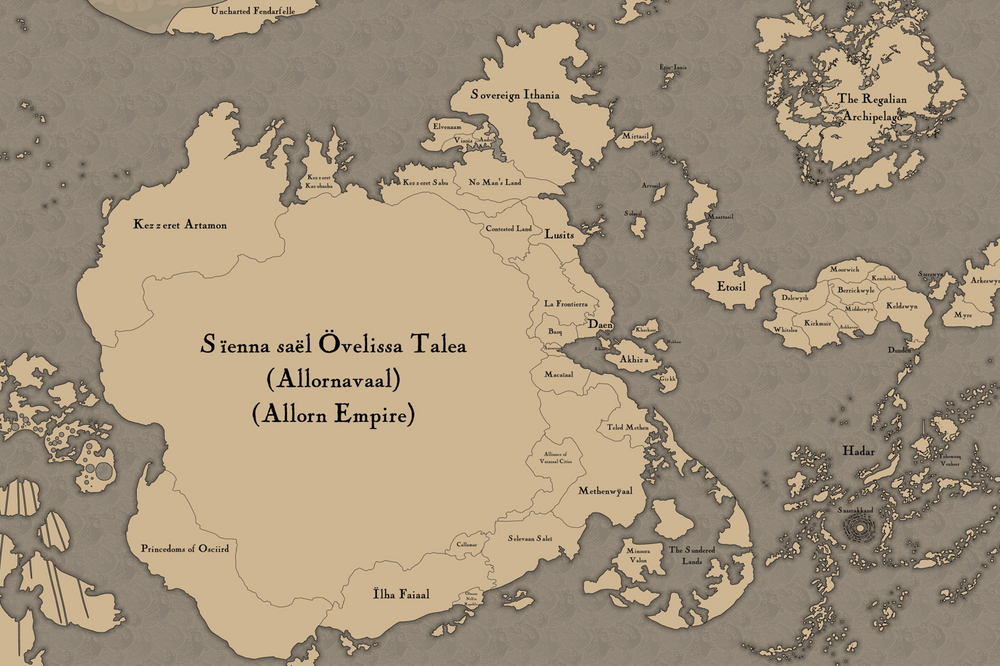 |
Other Information
Etiquette
- The traditional greeting between Teledden is a slight bow, bent a small degree at the waist with the hand held slightly out and palm facing upwards.
- The art of snide commentary hidden under a veneer of kindness is an art among the Teledden, and those who are good at it take pride to showcase their skill to others.
- Teledden can sometimes be very petty with their dislike of others, particularly towards one’s wardrobe. An extended cape or robe that can conveniently be stood upon and torn is sometimes too much of an irresistible torment to inflict on those not liked.
- The Teledden version of spitting on someone is the backhand-clap. The way this is done to hold one’s hand with the palm facing towards one’s own face stretched out in front of them, followed by the back of the other hand clapped firmly into the palm of the other, once.
- The act of ritually brewing tea or Kaffee for another person is considered a sign of deference or respect, especially when it is brewed in a vessel sitting in a bowl of Eelt-Stones, magical blue glowing pebbles that can become as warm as fire when heated. Most Teledden have a small supply of Eelt-Stones which they enjoy keeping in engraved boxes, given a special place near their kitchen entrances.
- Fashion is often used to make subtle gestures. Political events may see cadres dressed in the same colors and fabrics to denote loyalties: jewelry and accessories may all have intentions behind them.
Leisure
- Teledden have a party game called Ëllenanla or just Nanla, where a party host pairs off guests and has them debate about things they are passionate about before rotating every set amount of minutes as a way to get to know one another.
- Teledden love buying paintings of themselves doing something heroic, even if the action is completely fictional. Only ever one or two, but if a visitor looks hard enough in a Teledden home, it is almost guaranteed to exist somewhere.
- Teledden are borderline vegetarian. Cuisine has many floral notes and exotic fantasy spices, though also mundane ones like saffron. Teledden have a dislike of salt, preferring a synthetic flower called Ullaline.
- The Teledden make a game of poetry, using the Altalar language’s archaic forms of grammar, tense, and structure to double-, triple-, or even quadruple-layer their verses with meaning. The greater the amount of implicit meanings, the more renown a poet earns among other Teledden.
Culture
- Teledden cavalry is noted as some of the most skilled in known history, with the Silverlances of the Allorn Empire having near-legendary status from their string of victories that was nigh unbroken until Cataclysm. Allorn martial history as a whole is littered with glorious heroes, army chapters and last-stands turned pyrrhic victories, the modern Allorn citizen drawing on endless chronicles to be inspired for their future military career.
- The Teledden law system is based on “law by debate,” where if a guilty party is brought to court, they must debate with their accuser until the judge throws laurels at the one who has produced a rhetorically superior argument. Far from the slow, methodical process of later Regalian law, this method of Allorn Trial relies on the verbal sharpness of the participants to ensure that justice is served.
- Because of the underclass being composed completely of slaves, the Teledden do not recognize class divides between themselves. There is a saying that every citizen is a noble in Allorn society, and every citizen is deserving of respect, as most have a great ancestor who did something noteworthy or gained the attention of an Empress. Powerful Allorn nobles do not have a hereditary or divine claim to this power, only the strength to take and keep it.
- Since the Cataclysm, some Teledden have chosen to ‘watch over’ the bloodlines of some of their shorter-lived friends. Far from wholesome, more politically-minded Teledden have been known to pitch their late friends’ families together in the form of a high-stakes strategy game.
- Observation of the heavens is a cornerstone of Teledden culture and their academic studies, regardless of the field. This is largely due to the long, predictable history the Allorn have had with the heavens, and their names for the various Celestial Bodies are commonly taught across Aloria.
- Many forget today that the Teledden were the greatest craftsmen for millennia, weaving unique spells with forged, carved and built creations to stunning results. While many of the greatest examples of their skills are long lost, Materials such as Ephamaria, Nightsilver, Pattara, and Savellani Shaping Substance are forever tied with their ancient creators or greatest users.
- Teledden music sounds like a more ethereal and slow-pitched version of Daendroque music, which though the Daendroque refuse to admit it, is somewhat derivative of theirs. It is dominated by melancholic and harp-like echoing guitars, as well as flutes and other graceful instruments that let the focus rest on the voice. Indeed, Teledden accents in Common are also relatively Daendroque-sounding (Spanish-esque), due to sound similarities.
- Allorn Tarot is an unusual fortune-telling method. Though the physical deck only has 32 cards, each card can magically manifest 64 different ways, creating 2048 cards total. Unlike the more direct Ailor Tarot, Allorn Tarot is full of millennia worth of esoteric symbols with their own lore, such as the Golden Mirror (with the face of the god Aseia staring at the viewer in its reflection) symbolizing vanity and obsession, the Eye of Naëssar (a silver iris ringed with blue) symbolizing the hunt for evil, and more. Allorn Tarot is usually Arcane and referential in nature, and a player can run it in any way that makes sense.
General
- Teledden are excellent tower-builders. Their cities look like a wall of bristling marble spears pointing up towards the skyline, all designed with lavish views and imposing structure in mind, not necessarily ease of use. Some older buildings have Magic elevators from the Allorn era.
- Alongside being the greatest builders of towers in Aloria, tower-cleaners is another title they hold. Ciel'lapanna Cranes, slaves, and unique magical incantations are part of their arsenal of cleaning to help keep their structures looking pristine.
- Teledden librarians are often also trained as analysts and intelligence officers at the Great Library of Ivaëlle, or the Lessariaton, which has given the colloquial name “Lesarra” to those who live within its walls and devote themselves to the study of knowledge. Many of them have thrown their lot in with the Blue Moon Society, the secret service of the new Allorn Empire.
- In the province of Methenwÿaal, a cabal of powerful Teledden Mages refuse to bend the knee to the Allorn Empire. Even Allorn nationalists blanch at the tales of horror and arcane experimentation that come out of the forsaken land, but those permitted to study with them recount once returning home that they are far too powerful to be dealt with in any easy way.
- Teledden have not adjusted their Elven perception of time to the Ailor-dominated modern era. Many of them can still hold grudges for something an Ailor family would see as generations ago, leading to situations where households have been ruined by a Teledden they do not even know for something that was never told to them by an ancestor.
- There is an unusually large Teledden diaspora in Ithania, from the days when the Allorn Empire ruled there. They helped give rise to the Ithanian culture, and some of their elders still play a role in the management of the Kingdom.
- Most urban centers in regions that tolerate the practice of Magic have a “Teledden Quarter”. It would not be surprising to find a Teledden in the streets even as far as distant Korbamakora, the capital of the Songaskian Masaya two continents and half the world away.
- The infighting of the later years of the initial Allorn Empire are an incredibly sore topic. Most Teledden are well aware of relatives that fought against the Empire in its waning days, or know that their family lost something in the collapse, or mourn the disappearance of Magic.
- Some less composed Teledden make crass jokes. Common ones include that the Avantl have no concept of the wheel, that Sihndar are so corrupted that they do not decompose, and the Xieloth all live next to windmills.
- Ellon-Wing kites are a common item seen flying high in the air during Teledden festivals, mimicking the appearance of the creature, and one of many creations taken and adapted from the distant Sihai.
- Ulaan-Shiraal antlers are just about the only bones accepted to be carved, worn or generally use. The most beautiful objects are Ulaan-Shiraal lyres, which use the natural curl of the horns to support their string structure in addition to beautiful wood and gold.
- While many high-class Teledden disdain the presence of pets and small animals, they do commonly enjoy the keeping and training of birds like the Crowned Eflaln. There is just something about training them that speaks to core Teledden sensibilities.
- The Sundered Lands, a region of southern Teledden territory which fell into the sea during the Cataclysm, are currently undergoing a gradual recovery process facilitated by some of the most advanced Magic the Teledden have at their disposal.
Trivia
- Why play a Teledden? Because you like Teledden. And winning. Teledden win a lot.
- Some historians hold that ancient Teledden used to have longer ears.
- Two Teledden families have been fighting over ownership rights to a pear tree for 4,000 years.
| ||||||||||||||||||||||
| Accreditation | |||||||||
|---|---|---|---|---|---|---|---|---|---|
|
| ||||||||
